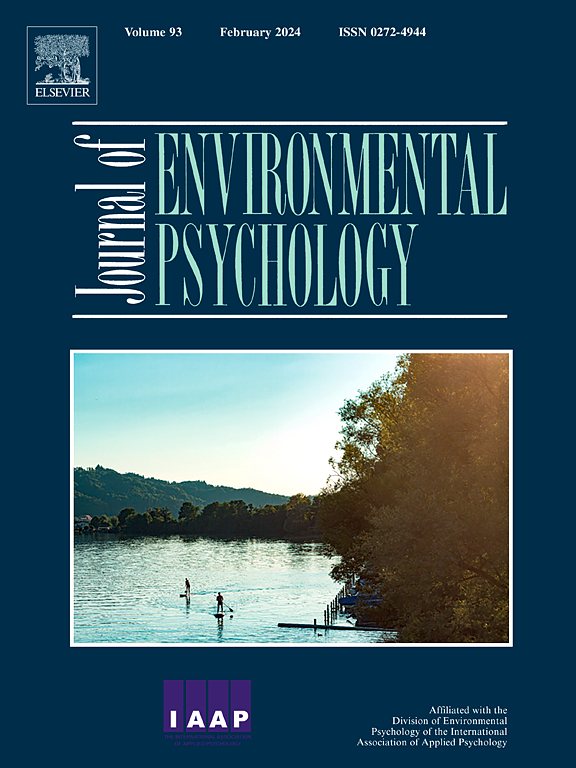Capturing nature Connectedness: Validity and utility of the Dutch nature connection index
IF 7
1区 心理学
Q1 ENVIRONMENTAL STUDIES
引用次数: 0
Abstract
Nature connectedness is increasingly recognized for its role in promoting mental health and planetary health. Valid nature connectedness scales are crucial to study these relations. While several scales exist to measure this construct, there is a need for improvement in their methodological quality. This study aimed to evaluate the validity and utility of the Dutch translation of the Nature Connection Index (NCI), a scale originally developed in English by Hunt et al. (2017) and Richardson et al. (2019). Survey data from two samples of young adults aged between 18 and 35 years were used (n = 1728; n = 1608). Confirmatory Factor Analysis and Exploratory Factor Analysis were performed, and Cronbach's alfa was calculated. Pearson's correlations between the NCI and measures of nature connectedness, nature contact, climate change importance, and mental wellbeing were analyzed to evaluate concurrent validity, convergent validity, and the utility of the NCI. Utility was further assessed by testing the NCI's ability to detect socio-demographic differences using one-way ANOVA. Consistent with the original English scale, the Dutch version of the NCI loaded onto a single factor and demonstrated high internal consistency (α = 0.89). Strong correlations with another measure of nature connectedness, moderate correlations with nature contact and climate change importance, and weak correlations with mental wellbeing outcomes were found. Additionally, NCI scores differed across subgroups defined by gender, education level, relationship status, and student status. The findings suggest that the Dutch NCI is reliable and valid instrument for measuring nature connectedness in Dutch speaking populations.
捕捉自然联系:荷兰自然联系指数的有效性和实用性
人们日益认识到自然联系在促进心理健康和地球健康方面的作用。有效的自然连通性量表对于研究这些关系至关重要。虽然存在几个尺度来衡量这种结构,但需要改进它们的方法质量。本研究旨在评估自然连接指数(NCI)荷兰语翻译的有效性和效用,NCI是由Hunt等人(2017)和Richardson等人(2019)最初用英语开发的量表。调查数据来自两个样本,年龄在18至35岁之间的年轻人(n = 1728;n = 1608)。进行验证性因子分析和探索性因子分析,并计算Cronbach’s alpha。分析了NCI与自然连通性、自然接触、气候变化重要性和心理健康之间的Pearson相关性,以评估NCI的并发效度、收敛效度和效用。通过使用单因素方差分析测试NCI检测社会人口统计学差异的能力,进一步评估效用。荷兰语版NCI量表与英语原版量表一致,加载到单因素上,具有较高的内部一致性(α = 0.89)。与自然联系的另一种测量方法存在强相关性,与自然接触和气候变化重要性存在中等相关性,与心理健康结果存在弱相关性。此外,NCI分数在由性别、教育水平、关系状况和学生身份定义的亚组之间存在差异。研究结果表明,荷兰NCI是衡量荷兰语人口自然联系的可靠和有效的工具。
本文章由计算机程序翻译,如有差异,请以英文原文为准。
求助全文
约1分钟内获得全文
求助全文
来源期刊

Journal of Environmental Psychology
Multiple-
CiteScore
10.60
自引率
8.70%
发文量
140
审稿时长
62 days
期刊介绍:
The Journal of Environmental Psychology is the premier journal in the field, serving individuals in a wide range of disciplines who have an interest in the scientific study of the transactions and interrelationships between people and their surroundings (including built, social, natural and virtual environments, the use and abuse of nature and natural resources, and sustainability-related behavior). The journal publishes internationally contributed empirical studies and reviews of research on these topics that advance new insights. As an important forum for the field, the journal publishes some of the most influential papers in the discipline that reflect the scientific development of environmental psychology. Contributions on theoretical, methodological, and practical aspects of all human-environment interactions are welcome, along with innovative or interdisciplinary approaches that have a psychological emphasis. Research areas include: •Psychological and behavioral aspects of people and nature •Cognitive mapping, spatial cognition and wayfinding •Ecological consequences of human actions •Theories of place, place attachment, and place identity •Environmental risks and hazards: perception, behavior, and management •Perception and evaluation of buildings and natural landscapes •Effects of physical and natural settings on human cognition and health •Theories of proenvironmental behavior, norms, attitudes, and personality •Psychology of sustainability and climate change •Psychological aspects of resource management and crises •Social use of space: crowding, privacy, territoriality, personal space •Design of, and experiences related to, the physical aspects of workplaces, schools, residences, public buildings and public space
 求助内容:
求助内容: 应助结果提醒方式:
应助结果提醒方式:


